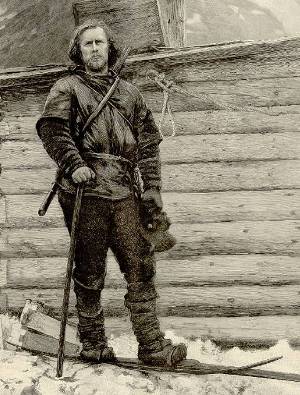
130 Years Ago
NANSEN’S FIRST LONG JOURNEY
In the winter of 1884, when Norway's Fridtjof Nansen was 22 years old, he got a foretaste of treks to come. He decided to enter the annual Huseby Hill ski jump. He took a leave of absence from the National Museum of Bergen, where he was a natural-history curator. There was one hitch—Huseby Hill was in Oslo (then Christiania), and Nansen was in Bergen, 215 miles away. Impetuously, Nansen decided to travel the only way he could on such short notice, mostly by ski. Taking into account train rides at either end, and passages by steamer and hired sleigh, he skied about 150 miles in six days. Arriving on Sunday he got some rest, and on Monday he entered the Huseby Hill jumping meet, forerunner of today's Holmenkollen competition. He placed ninth.–ALLAN POSPISIL, SPORTS ILLUSTRATED (NOVEMBER 1979)
75 Years Ago
HOW TO STORE SKIS, BOOTS IN SUMMER
All too often, at the first sign of snow, one goes to the cellar or attic and finds that last year’s new skis are warped, and leather straps and boots have taken on a greenish color from mold. Good equipment is worthy of care. With skis, clean all wax from the running surface; gasoline will do the job in short order. To seal the skis, spread linseed oil on their running surface, then turn them upside down and leave them that way so the oil soaks into the wood. After four to six weeks, wipe off the excess oil. Apply floor wax to the top of the skis. Boots and leather binding straps should be greased and wrapped in paper. Also stuff paper into the boots to keep them in their original shape.–EMPIRE STATE NEWS (MARCH 1939)
65 Years Ago
AMERICAN SCHOOL KIDS WOULD BENEFIT FROM WINTER VACATIONS
During his student days in Switzerland, Averell Harriman, who developed Sun Valley, was awakened to the need for winter sports and year-round vacation facilities. One-sixth of the nation’s school facilities go unused because of the practice of closing schools in summer. In the Swiss system of staggering school vacations in a three-year cycle, Bern, Basel and Zurich each takes a turn at early, middle and late closings.–SKI MAGAZINE (FEBRUARY 1949)
45 Years Ago
TABLE-POUNDING BEATTIE
At the close of this ski season, Bob Beattie will cease to be director of the alpine program of the U.S. Ski Association. Thanks to Beattie, the position of U.S. competitors today is a far cry from the days when the Europeans tagged him as the Ugly American. Ugly because he pounded tables and shouted to get his boys better seedings. And didn’t relent. Beattie has been a master tactician at gaining every advantage possible for our racers. He’ll be sadly missed.– DOUG PFEIFFER, SKIING MAGAZINE (FEBRUARY 1969)
40 Years Ago
ANNEMARIE PROELL AT THE TOP OF HER GAME
At the FIS World Alpine Ski Championships in St. Moritz next week there is but one true monarch in sight— Queen Annemarie of Austria. This fierce and arrogant mountain queen rules supreme. She still lights up a defiant cigarette at the finish line after most races, still treats her competition with a disdain suitable for stray dogs, still plays the imperious and outrageous prima donna for befuddled officials of the Austrian team—as last fall when she threatened to quit and race for San Marino in 1974 unless she was allowed to change her brand of skis. Yes, the aggressive, intolerant, petulant, magnificent Annemarie Proell is still with us to dominate World Cup skiing as no one has since Jean-Claude Killy departed six long years ago. And she is only 20.–WILLIAM OSCAR JOHNSON, SPORTS ILLUSTRATED (JANUARY 1974)
25 Years Ago
VAIL: “THE LAST THING I’LL SELL, EVER”
George Gillett bought the whole spread for $130 million in 1985 and has since pumped in some $51.4 million, including the China Bowl project and improvements at Beaver Creek. His Colorado kingdom is probably worth $400 million now. "Vail is the last thing I will sell—ever,” says Gillett. “This is my family's home, and Vail will always be ours." His attachment to the mountains seems genuine. He gets his kicks on the slopes, stopping to commiserate with any and all lost, confused or fallen skiers he comes across, chatting them up, helping them off the mountain if they are hurt—and rarely identifying himself as the owner of the hill. "What I'm trying to instill in this place is an innate sense of hospitality," he explains.–WILLIAM OSCAR JOHNSON, SPORTS ILLUSTRATED (JANUARY 1989)
25 Years Ago
SKIERS RAPIDLY GROWING OLDER
The leading edge of the baby boom will hit the unprepared like a Tsunami. Since 1987, according to market researcher Jim Spring, the number of skiers 55 years and older has increased by nearly 40 percent. More than half didn’t learn to ski until they were 36 or older. Seniors are attracted by fun, companionship, and skill improvement. Saving money is not a priority.–DINAH WITCHEL, SKI AREA MANAGEMENT (JULY 1989)
20 Years Ago
REMEMBERING STAPLETON AIRPORT
Denver International Airport (DIA), replacing 65-year-old Stapleton as the Rocky Mountain West’s air transportation hub, is expected to open in time for the spring skiing crush. The crush was Stapleton’s hallmark. It wasn’t uncommon for skiers and other travelers to pack the concourses and sleep on floors as flights were delayed by snowstorms. In bad weather simultaneous takeoffs and landings were prohibited because runways were too close together. Between 1990 and 1993, Stapleton logged 57 near mid-air collisions.– MADELEINE OSBERGER, SNOW COUNTRY (MARCH-APRIL 1994)
Category:
Snapshots
